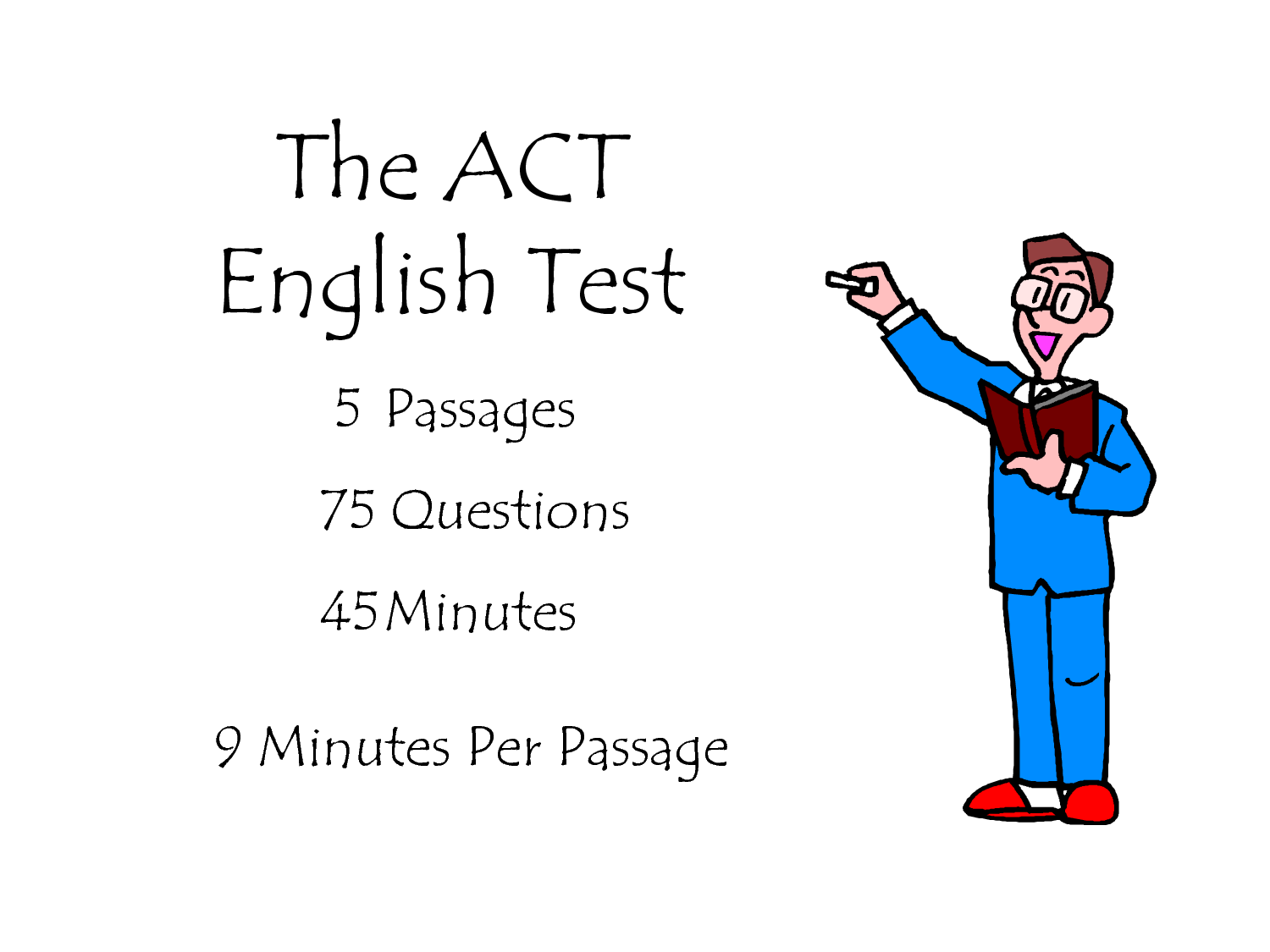8 Tips for the ACT English Section

The ACT’s English section stands as a formidable beginning to the exam. It tasks students with answering 75 questions in 45 minutes (an average of just 36 seconds per question) on a number of different topics surrounding grammar usage and rhetorical skills, all based on the context of 5 passages of various styles. With this in mind, it is no surprise that many students feel intimidated by this section of the exam, but here are some tips to help create a stress-free approach to the section.
Tip # 1: Review the rules of grammar. DO NOT rely on what “sounds right”
It may seem obvious that studying grammar is something students can do to improve on the English section, but many students, especially native English speakers, often fall back on a lifetime of experience in what “sounds correct” rather than approaching the mechanics of a sentence. For example, many students who see the statement below will instinctively be able to identify the error.
"The scientific community do not agree on the cause of these changes, but there is unanimous agreement about the effects they could have on the environment."
Those students may implicitly realize the phrase “The scientific community do not agree” is incorrect and that it should be “The scientific community does not agree”. However, when asked to explain why that is the case, many students will struggle and simply say “because it sounds better”, rather than identifying that the subject “The scientific community” is singular and agrees with the singular verb phrase “does not” but not the plural verb phrase “do not”.
The ACT knows this is how many students approach this section, so they will intentionally construct sentences which may “sound good”, but actually be grammatically incorrect. Take the example below.
The team’s strong play over the past 10 games has led them to the top of the standings.
-
-
-
- NO CHANGE
- have led them
- has led it
- have led them
-
-
Many students will choose choice A because it “sounds right”; it’s likely the exact phrasing they have heard dozens of times from sportscasters in the media. However, if they were to approach this sentence from its mechanics, they would be more likely to realize that the answer should be choice C because the singular pronoun “it” is needed to agree with the singular antecedent “the team”.
Tip # 2: Study for common question types
One of a student’s greatest advantages in studying for the ACT is that the exam is extremely predictable. The same 20-25 rules of grammar are tested on each exam along with only a handful of different types of questions regarding rhetoric. Knowing not only what topics will be tested, but which ones are tested most frequently, can help students know which rules can yield the greatest results with the least amount of effort. For example, studying rules surrounding verb usage might be able to aid students in answering 7 questions per exam while understanding reflexive pronouns as used in phrases such as “I myself” or “they themselves”, would likely only be helpful on 1 question per exam.
Tip # 3: Don’t be afraid to pick “NO CHANGE”
This is a common concern among many students new to the ACT. In school, most exams present students with a problem and then ask them to resolve it, so it’s understandable why it seems so counterintuitive to pick an answer which states “there is no problem”. However, the “NO CHANGE” option is present on nearly every question on the ACT, and is correct just as often any other answer choice.
Tip # 4: Read the entire sentence
The most common refrains I hear from students while reviewing their work on an ACT English section are “It was a silly mistake” or “I misread the sentence”, and most of those errors are the result of students trying to shorten sentences to save on time. As covered in tip # 1, the ACT knows students often try to take shortcuts to save time on a tightly timed section, so its sentences are often arranged in a way which can make incorrect answers seem correct if not read in the context of the full sentence.
Example:
The Climate Science and Environmental Action Committee consisting of representatives from the student body along with community leaders have explored numerous ways in which they can make eco-friendly changes in their own community.
-
-
-
- NO CHANGE
- explore
- has explored
- are exploring
-
-
The correct answer should be choice C because the singular verb phrase “has explored” agrees with the singular subject “The Climate Science and Environmental Action Committee”, but if a student were to begin reading just before the underlined portion, they could mistakenly view the sentences as “community leaders have explored numerous ways in which they can make eco-friendly changes in their own community”, which would change the subject to the plural “community leaders” and lead to confusion.
Tip # 5: Use the answer choices to your advantage
This is a great tip to help get into the habit of approaching a question through its mechanics, and it can also help students help manage time by getting directly to the root of what a question wants to know. There is a lot of information that students must remember in order to do well on the ACT English section including multiple rules regarding verbs, pronouns, commas, dashes, clauses, and diction, just to name a few. To make questions less overwhelming, it can be helpful for students to look at the answer choices and note what the differences are between them before even reading the sentence. For example, let’s look at the answer choices from Tip #4.
-
-
-
- have explored
- explore
- has explored
- are exploring
-
-
What’s different about each of these answer choices? It is their use of verbs. Immediately, a student can tell that they probably don’t need to consider any rules regarding other parts of speech or punctuation, and that the question will most likely boil down to just two simple rules: subject-verb agreement and verb tense.
Tip # 6: Eliminate answer choices that mean the same thing
Another benefit of looking at the answer choices is that students can eliminate answer choices that serve the same purpose, sometimes even answering the question without reading the sentence. For example, consider the following answer choices.
-
-
-
- NO CHANGE
- ship; he
- ship. He
- ship, and he
-
-
It’s clear that the primary difference between the answer choices has something to do with punctuation (A is a mystery answer, B has a semicolon, C has a period, and D has a comma), so students can already narrow their focus to only rules regarding that topic. However, a keen observer might also note that the semicolon in choice B, the period in choice C, and the comma with a conjunction in choice D all serve the same purpose of separating two independent clauses. That means choices B, C, and D are identical, and since they cannot all be correct, the only remaining answer choice is A.
Tip # 7: Pick the most concise answer
A common theme among answers surrounding phrasing on the ACT English section is simply that the best answers are often the most concise. It’s for this reason that I always advise students to consider “Delete the underlined portion” whenever it is an answer choice because there is no better way to make a sentence more concise than by deleting part of it. Also, unlike “NO CHANGE”, this answer does not appear frequently on the test and is frequently correct. Further, always look out for redundancies or awkwardly phrased sentences; those are often signs that the shortest answer choice may be the most clear.
Example:
In 2009, Astronaut Michael Massimino performed two spacewalks in outer space as part of his mission with the STS-109 Columbia.
-
-
-
- NO CHANGE
- performed in outer space two spacewalks as part of his
- performed two spacewalks while not on Earth during his
- performed two spacewalks as part of his
-
-
All of these answer choices say essentially the same thing, but only choice D eliminates the redundancy of explaining that the spacewalk took place in space or “not on Earth”.
Tip # 8: Give the exam what it asks for
A common trap found in most ACT English sections is the inclusion of questions that ask not about what makes a statement more correct, but instead ask students to choose a statement that best accomplishes a specific goal. Unfortunately, over the course of 75 questions over a short period of time, it is easy to fall into the habit of simply looking at the answer choices, choosing the one that is most clear, and missing the questions included above some of those choices. As soon as a student sees a question above the answer choices on the ACT English section, they should immediately underline exactly what the question asks for.
Example
Much of the state’s landscape has drastically changed since the Catskill Mountains began to form in the distant past.
Which of the following most specifically illustrates how much time has passed since the Catskill Mountains formed?
-
-
- NO CHANGE
- 350 million years ago.
- a long time ago.
- during previous eras.
-
All of these answer choices could theoretically work within the context of the sentence, granted that some would likely sound somewhat awkward. However, if we isolate what the question is asking for — to “specifically illustrate how much time has passed” — the answer should become quite clear. Only choice B is specific about time, while choices A, C, and D are all somewhat vague.
Hopefully, through these tips and consistent practice, students can come to see the ACT English section for what it is: not an insurmountable challenge, but a predictable section grounded by a standard set of rules that students can study and plan.


